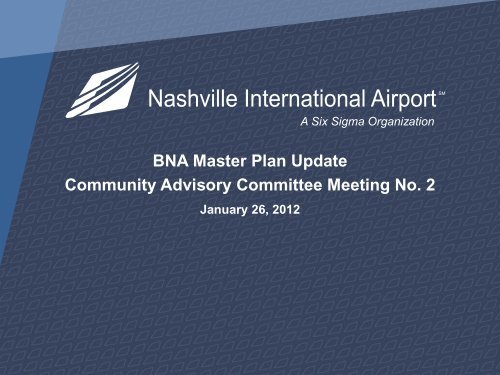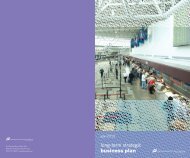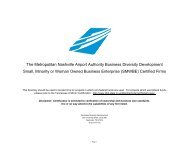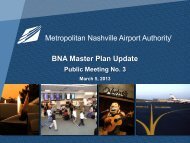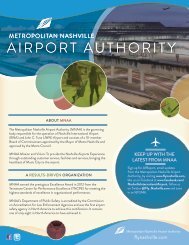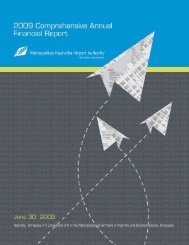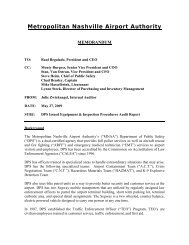BNA Master Plan Update Community Advisory Committee Meeting No 2
Community Advisory Committee Meeting - Nashville International ...
Community Advisory Committee Meeting - Nashville International ...
Create successful ePaper yourself
Turn your PDF publications into a flip-book with our unique Google optimized e-Paper software.
A Six Sigma Organization<br />
A Six Sigma Organization<br />
<strong>BNA</strong> <strong>Master</strong> <strong>Plan</strong> <strong>Update</strong><br />
<strong>Community</strong> <strong>Advisory</strong> <strong>Committee</strong> <strong>Meeting</strong> <strong>No</strong>. 2<br />
January 26, 2012
A Six Sigma Organization<br />
Agenda<br />
• Introductions<br />
• The Airport <strong>Master</strong> <strong>Plan</strong> Process<br />
• Status of the <strong>BNA</strong> <strong>Master</strong> <strong>Plan</strong> <strong>Update</strong><br />
• Overview of Aviation Demand Forecasts<br />
• Demand/Capacity Analysis & Facility Requirements<br />
• Sustainability <strong>Master</strong> <strong>Plan</strong><br />
• Next Steps<br />
• Project Schedule<br />
• Comments/Questions
A Six Sigma Organization<br />
Introductions<br />
• MNAA Staff<br />
• RW Armstrong Team<br />
• Technical <strong>Advisory</strong> <strong>Committee</strong><br />
• Others
A Six Sigma Organization<br />
Status<br />
• Inventory of Existing Conditions<br />
• Finalized Working Paper <strong>No</strong>. 1<br />
• Aviation Demand Forecasts<br />
• Finalizing Working Paper <strong>No</strong>. 2<br />
• Began Demand/Capacity Analysis & Facility<br />
Requirements<br />
• Began Airport Landside Development <strong>Plan</strong>
A Six Sigma Organization<br />
The Airport <strong>Master</strong> <strong>Plan</strong> Process<br />
Aerial Survey & Mapping<br />
Implementation<br />
<strong>Plan</strong><br />
Pre-<strong>Plan</strong>ning,<br />
Study<br />
Design,<br />
Secure<br />
Funding<br />
Inventory<br />
Existing<br />
Conditions<br />
Activity &<br />
Demand<br />
Forecasting<br />
Demand/<br />
Capacity<br />
Analysis &<br />
Facility<br />
Requirements<br />
Alternative<br />
Development<br />
Concepts<br />
Final<br />
Documents &<br />
<strong>Plan</strong><br />
Adoption<br />
ALP <strong>Plan</strong> Set<br />
Public Involvement - Study <strong>Advisory</strong> <strong>Committee</strong>s<br />
= complete = in progress/to be completed = ongoing
A Six Sigma Organization<br />
Overview of Aviation Demand Forecasts<br />
• Forecast of Air Carrier Enplanements<br />
• Used to determine existing and future passenger<br />
terminal area requirements<br />
• Forecast of Air Carrier Operations<br />
• Used to determine existing and future airfield and<br />
terminal requirements in accommodating aircraft<br />
• Forecast of General Aviation Operations<br />
• Used to ensure adequate airfield and GA facilities are<br />
available for GA activities<br />
• Forecast of Air Cargo Operations<br />
• Used to ensure adequate airfield and cargo facilities are<br />
available for existing and future cargo operations
A Six Sigma Organization<br />
Aviation Demand – Forecast Scenarios<br />
• Forecast of Air Carrier Enplanements & Operations<br />
• Historic – Relies on projecting historic data<br />
• Market Share – Assumes constant level of enplanements<br />
relative to national activity<br />
• Adjusted Market Share – Adjusts for <strong>BNA</strong>’s above-average<br />
growth compared to the national average<br />
• Regression Analysis (preferred) – Based on relationship<br />
between fluctuations in regional population and historic Airport<br />
activity<br />
• Alternate Air Carrier Forecasts<br />
• Southwest-AirTran merger traffic gains<br />
• Charter activity growth<br />
• Domestic high growth<br />
• International traffic growth
A Six Sigma Organization<br />
Aviation Demand – Forecast Scenarios<br />
• Forecast of Air Cargo Operations<br />
• Static Market Share (preferred) – Assumes current number of<br />
integrated express and domestic all-cargo carriers will remain<br />
constant<br />
• High-Growth Cargo – Assumes resumption of service by China<br />
Airlines<br />
• Forecast of General Aviation Operations<br />
• Market Share – Assumes operations will grow in relation to the<br />
national rate<br />
• Regression Analysis (preferred) – Based on relationship<br />
between fluctuations in regional population and historic Airport<br />
activity
A Six Sigma Organization<br />
Historic <strong>BNA</strong> Enplanements<br />
Year Enplanements<br />
2000 4,471,162<br />
2001 4,359,287<br />
2002 3,979,509<br />
2003 3,953,056<br />
2004 4,219,890<br />
2005 4,479,213<br />
2006 4,700,818<br />
2007 4,920,702<br />
2008 4,725,071<br />
2009 4,381,508<br />
2010 4,446,988
A Six Sigma Organization<br />
2011 <strong>BNA</strong> Preferred Forecast – Enplanements<br />
Year Enplanements<br />
2001 4,359,287<br />
2006 4,700,818<br />
2011 4,724,974<br />
2016 5,737,140<br />
2021 6,812,234<br />
2026 8,051,645<br />
2031 9,495,468
A Six Sigma Organization<br />
Historic <strong>BNA</strong> Air Carrier Operations<br />
Year<br />
Operations<br />
2000 129,455<br />
2001 130,262<br />
2002 118,936<br />
2003 138,072<br />
2004 139,916<br />
2005 148,258<br />
2006 137,512<br />
2007 142,040<br />
2008 137,065<br />
2009 127,778<br />
2010 122,068
A Six Sigma Organization<br />
2011 <strong>BNA</strong> Preferred Forecast – Air Carrier Operations<br />
Year<br />
Operations<br />
2001 130,262<br />
2006 137,512<br />
2011 124,590<br />
2016 141,218<br />
2021 158,275<br />
2026 177,266<br />
2031 198,590
A Six Sigma Organization<br />
Historic <strong>BNA</strong> General Aviation Operations<br />
Year Operations<br />
2000 89,547<br />
2001 77,912<br />
2002 75,366<br />
2003 70,551<br />
2004 75,503<br />
2005 70,954<br />
2006 64,158<br />
2007 62,608<br />
2008 54,513<br />
2009 43,923<br />
2010 45,060
A Six Sigma Organization<br />
2011 <strong>BNA</strong> Preferred Forecast – GA Operations<br />
Year Operations<br />
2001 77,912<br />
2006 64,158<br />
2011 43,870<br />
2016 48,615<br />
2021 53,877<br />
2026 59,711<br />
2031 66,181
A Six Sigma Organization<br />
Historic <strong>BNA</strong> Air Cargo Operations<br />
Year<br />
Operations<br />
2001 5,030<br />
2002 4,600<br />
2003 5,184<br />
2004 5,340<br />
2005 5,702<br />
2006 5,592<br />
2007 4,380<br />
2008 3,750<br />
2009 3,080<br />
2010 2,360
A Six Sigma Organization<br />
2011 <strong>BNA</strong> Preferred Forecast – Air Cargo Operations<br />
Year Operations<br />
2001 5,030<br />
2006 5,592<br />
2011 2,526<br />
2016 3,401<br />
2021 3,758<br />
2026 4,219<br />
2031 4,759
A Six Sigma Organization<br />
Demand/Capacity & Analysis of Facility Requirements<br />
• Analyzes the ability of existing facilities at <strong>BNA</strong> to<br />
accommodate current and projected activity<br />
• Identifies the most demanding aircraft projected to<br />
utilize <strong>BNA</strong> within the 20-year planning period<br />
• Identifies the deficiencies and/or need for facility<br />
enhancement
A Six Sigma Organization<br />
Demand/Capacity & Analysis of Facility Requirements<br />
• Airfield Requirements:<br />
• Airfield Capacity & Delay Considerations:<br />
• Airspace constraints<br />
• Airfield configuration (i.e., runway orientation,<br />
parallel taxiways, and exit taxiways)<br />
• Aircraft fleet mix<br />
• Considerations will be used to determine Airport<br />
Annual Service Volume (ASV)<br />
• Runway Requirements:<br />
• Critical aircraft<br />
• Runway length requirements<br />
• Runway width<br />
• Runway clearances<br />
• Runway wind coverage
A Six Sigma Organization<br />
Demand/Capacity & Analysis of Facility Requirements<br />
• Taxiway Requirements:<br />
• Review and document findings discussed in the recent<br />
<strong>BNA</strong> Taxiway Utilization Study<br />
• Additional Considerations:<br />
• Taxiway/taxilane deficiencies<br />
• Taxiway strength<br />
• Taxiway width<br />
• Taxiway separation from runways<br />
• Apron Requirements:<br />
• Adequacy of the existing apron areas to accommodate<br />
current and forecast fleet mix and levels of demand<br />
• Apron pavement strength<br />
• Additional/replacement facilities
A Six Sigma Organization<br />
Demand/Capacity & Analysis of Facility Requirements<br />
• Navigational and Landing Aid Requirements:<br />
• Adequacy of the existing navigational and landing aid<br />
facilities to accommodate current and forecast fleet mix<br />
and levels of demand<br />
• Need for additional/replacement facilities<br />
• Impact of new technology on airfield operations and<br />
navigational aid requirements<br />
• Gate and Terminal Space Requirements:<br />
• Airline support functions<br />
• Secured public area<br />
• Concessions<br />
• <strong>No</strong>n-secured public area<br />
• <strong>No</strong>n-public area
A Six Sigma Organization<br />
Demand/Capacity & Analysis of Facility Requirements<br />
• Support Facility Requirements:<br />
• General aviation facilities<br />
• Cargo facilities<br />
• Aviation fueling facilities<br />
• Aircraft rescue and firefighting facilities
A Six Sigma Organization<br />
Demand/Capacity & Analysis of Facility Requirements<br />
• Determine Commercial Development Potential:<br />
• Focuses on land uses at <strong>BNA</strong> including:<br />
• Preservation, protection, improvement, upgrade,<br />
and/or removal of existing development envelopes<br />
• Identification of locations for new development<br />
and/or re-development<br />
• Findings will be used in the Landside Development <strong>Plan</strong> task
A Six Sigma Organization<br />
<strong>BNA</strong> Sustainability Study<br />
• Overview of the Nashville International Airport Sustainability<br />
Study, and its relationship to the <strong>Master</strong> <strong>Plan</strong> <strong>Update</strong><br />
• Consultant Team: VHB/Vanasse Hangen Brustlin, Inc., in<br />
association with:<br />
• The LPA Group, Inc.<br />
• EnerNOC<br />
• KB Environmental Sciences, Inc.
Nashville International Airport<br />
VHB/Vanasse Hangen Brustlin, Inc.<br />
In association with<br />
The LPA Group, Inc.<br />
EnerNOC<br />
KB Environmental Sciences, Inc.<br />
January 26, 2012<br />
Sustainability Mission Statement:<br />
To sustain the heartbeat of the Mid-South by cherishing its resources to ensure Music City keeps flying high
<strong>Community</strong> <strong>Advisory</strong> <strong>Committee</strong> Agenda<br />
• Sustainability and Project Introduction<br />
• Existing Sustainability Initiatives at <strong>BNA</strong><br />
• Sustainability <strong>Plan</strong>ning Process and Project Status<br />
• Sustainability Study – <strong>Master</strong> <strong>Plan</strong> <strong>Update</strong> Coordination<br />
• Sustainability Study Goals and Objectives<br />
25<br />
Sustainability Mission Statement:<br />
To sustain the heartbeat of the Mid-South by cherishing its resources to ensure Music City keeps flying high
FAA Sustainable <strong>Master</strong> <strong>Plan</strong> Pilot Program<br />
• Introduced in 2010; scheduled to end in late 2012<br />
• Purpose of the Program: Evaluate ways to make<br />
sustainability a core objective at every airport by<br />
funding preparation of long-range planning documents<br />
at 10 airports around the country<br />
• <strong>Plan</strong>s to include initiatives for reducing environmental<br />
impacts and achieving economic benefits while<br />
increasing integration with local communities<br />
• FAA will use lessons learned to develop national<br />
program guidance on airport sustainability<br />
26<br />
Sustainability Mission Statement:<br />
To sustain the heartbeat of the Mid-South by cherishing its resources to ensure Music City keeps flying high<br />
http://www.faa.gov/airports/environmental/sustainability
Sustainability: An Approach to Airport Management<br />
• Airport sustainability planning is a holistic<br />
approach to managing an airport to ensure:<br />
• Economic viability,<br />
• Operational efficiency,<br />
• Natural resource conservation, and<br />
• Social responsibility.<br />
– Airports Council International-<strong>No</strong>rth America<br />
27<br />
Sustainability Mission Statement:<br />
To sustain the heartbeat of the Mid-South by cherishing its resources to ensure Music City keeps flying high
Examples of Existing Sustainability Initiatives<br />
• Recycling program: paper, plastic and metals, carpet,<br />
batteries, tires<br />
• Replacement of majority of original air handlers in terminal<br />
facility with more energy‐efficient units<br />
• Consolidated Rental Car Facility<br />
• Reclaimed water for car washing<br />
• On-site operational savings of 800k VMT annually<br />
• Funding support for arts/music programs at 4 local schools<br />
Sustainability Mission Statement:<br />
To sustain the heartbeat of the Mid-South by cherishing its resources to ensure Music City keeps flying high
<strong>Plan</strong>ning Process and Project Status <strong>Update</strong><br />
June – Oct 2011 Oct – Dec 2011 Dec 2011 – Mar 2012<br />
Phase 1<br />
Conduct<br />
Sustainability<br />
Baseline<br />
Assessment<br />
Establish<br />
Sustainability<br />
Goals &<br />
Objectives<br />
Identify<br />
Candidate<br />
Sustainability<br />
Initiatives<br />
Evaluate<br />
Candidate<br />
Initiatives<br />
Mar – July 2012 Apr – Aug 2012 May – <strong>No</strong>v 2012<br />
Phase 2<br />
Develop<br />
Sustainability<br />
Performance<br />
Targets<br />
Develop<br />
Implementation<br />
& Monitoring<br />
Program<br />
Prepare<br />
Sustainability<br />
Management<br />
<strong>Plan</strong><br />
29<br />
Sustainability Mission Statement:<br />
To sustain the heartbeat of the Mid-South by cherishing its resources to ensure Music City keeps flying high
Sustainability<br />
Study / <strong>Master</strong><br />
<strong>Plan</strong> <strong>Update</strong><br />
Coordination<br />
Sustainability Study<br />
Conduct Sustainability Baseline<br />
Assessment<br />
Identify Sustainability Goals &<br />
Targets<br />
Identify Sustainability Strategies<br />
Develop Implementation <strong>Plan</strong><br />
Prepare Final Sustainability <strong>Plan</strong><br />
<strong>Master</strong> <strong>Plan</strong><br />
Baseline/<br />
Facilities Assessment<br />
Alternatives<br />
Development<br />
Project Phasing<br />
Capital<br />
Improvement<br />
<strong>Plan</strong><br />
Stakeholder Participation & Public Outreach<br />
30<br />
Sustainability Mission Statement:<br />
To sustain the heartbeat of the Mid-South by cherishing its resources to ensure Music City keeps flying high
Integration of Sustainability into Existing Processes<br />
Sustainability Mission Statement:<br />
To sustain the heartbeat of the Mid-South by cherishing its resources to ensure Music City keeps flying high
Draft Sustainability Study Goals and Objectives<br />
• Enhance the economic vitality of <strong>BNA</strong> by maximizing<br />
aeronautical and non-aeronautical revenue opportunities.<br />
•Develop and maintain robust air service offerings<br />
•Strengthen ties to the Nashville market, customers, and<br />
contractors<br />
•Optimize passenger terminal and landside assets to enhance<br />
revenue<br />
•Maximize development opportunities of aeronautical and<br />
non-aeronautical lands<br />
•Develop and implement financial flexibility through cost<br />
containment, access to capital, and contingency planning<br />
Sustainability Mission Statement:<br />
To sustain the heartbeat of the Mid-South by cherishing its resources to ensure Music City keeps flying high
Draft Sustainability Study Goals and Objectives<br />
• Ensure proper investment in the safety, security, and<br />
development of the people working at and using <strong>BNA</strong> to<br />
enhance the work/passenger/visitor experience.<br />
•Maintain the highest level of safety and security for<br />
passengers, customers, contractors and employees<br />
•Enhance the Nashville Airports Experience<br />
•Develop the MNAA workforce by ensuring proper<br />
recruitment, training, retention, and diversity<br />
Sustainability Mission Statement:<br />
To sustain the heartbeat of the Mid-South by cherishing its resources to ensure Music City keeps flying high
Draft Sustainability Study Goals and Objectives<br />
• Develop and maintain facilities and infrastructure at <strong>BNA</strong> to<br />
support long-term, efficient, and flexible growth.<br />
•Foster asset management, life-cycle approach in construction<br />
operations to provide secure, flexible, and convenient facilities and<br />
equipment<br />
•Ensure safe and secure Information Technology and data systems<br />
•Develop plan for dealing with natural disasters and catastrophic<br />
events<br />
•Develop land effectively in and around <strong>BNA</strong> to enhance aeronautical<br />
and non-aeronautical uses<br />
Sustainability Mission Statement:<br />
To sustain the heartbeat of the Mid-South by cherishing its resources to ensure Music City keeps flying high
Draft Sustainability Study Goals and Objectives<br />
• Enhance the Nashville community.<br />
•Promote business diversity<br />
•Strengthen relationships and improve communication with<br />
community partners and entrepreneurs<br />
•Minimize incompatible land uses surrounding <strong>BNA</strong><br />
Sustainability Mission Statement:<br />
To sustain the heartbeat of the Mid-South by cherishing its resources to ensure Music City keeps flying high
Draft Sustainability Study Goals and Objectives<br />
• Protect valuable natural resources in and around <strong>BNA</strong>.<br />
•Minimize environmental release and water quality noncompliance<br />
occurrences<br />
•Maximize water conservation and minimize water use<br />
•Minimize solid waste and increase recycling<br />
•Monitor <strong>BNA</strong>’s contribution to the Metropolitan Nashville<br />
region’s air quality environment<br />
•Monitor greenhouse gas (GHG) emissions from MNAAcontrolled<br />
activities<br />
•Manage existing sensitive natural resources on airport<br />
property<br />
Sustainability Mission Statement:<br />
To sustain the heartbeat of the Mid-South by cherishing its resources to ensure Music City keeps flying high
Draft Sustainability Study Goals and Objectives<br />
• Minimize use and reliance on traditional energy sources to<br />
promote cost savings and environmental stewardship.<br />
•Manage energy use<br />
•Evaluate renewable energy options<br />
Sustainability Mission Statement:<br />
To sustain the heartbeat of the Mid-South by cherishing its resources to ensure Music City keeps flying high
Draft Sustainability Study Goals and Objectives<br />
• Enhance surface transportation connectivity with the<br />
Airport service area.<br />
•Create and implement an MNAA parking plan<br />
•Foster intermodal transportation options at <strong>BNA</strong><br />
•Regularly collect passenger and employee surface<br />
transportation mode share data<br />
Sustainability Mission Statement:<br />
To sustain the heartbeat of the Mid-South by cherishing its resources to ensure Music City keeps flying high
Energy Evaluation – Modeling of Passenger<br />
Terminal Facility<br />
Sustainability Mission Statement:<br />
To sustain the heartbeat of the Mid-South by cherishing its resources to ensure Music City keeps flying high
Energy Evaluation – Modeling of Passenger<br />
Terminal Facility<br />
Sustainability Mission Statement:<br />
To sustain the heartbeat of the Mid-South by cherishing its resources to ensure Music City keeps flying high
Energy Evaluation – Model Output<br />
Sustainability Mission Statement:<br />
To sustain the heartbeat of the Mid-South by cherishing its resources to ensure Music City keeps flying high
What is your sustainability vision for the Airport?<br />
• What areas or activities should be focused on in the Study?<br />
• What can MNAA do to support the sustainability goals of<br />
its stakeholders?<br />
• What sustainability-related goals/objectives do you think<br />
MNAA should strive for?<br />
Sustainability Mission Statement:<br />
To sustain the heartbeat of the Mid-South by cherishing its resources to ensure Music City keeps flying high
A Six Sigma Organization<br />
Next Steps<br />
• Finalize Aviation Demand Forecasts (Working Paper <strong>No</strong>. 2)<br />
• Complete Demand/Capacity Analysis & Facility Requirements<br />
(Working Paper <strong>No</strong>. 3)<br />
• Continue Landside Development <strong>Plan</strong><br />
• Conduct March 29, 2012 <strong>Meeting</strong>s:<br />
• Technical <strong>Advisory</strong> <strong>Committee</strong> <strong>Meeting</strong> <strong>No</strong>. 3<br />
• <strong>Community</strong> <strong>Advisory</strong> <strong>Committee</strong><br />
<strong>Meeting</strong> <strong>No</strong>. 3<br />
• Public <strong>Meeting</strong>/Workshop <strong>No</strong>. 1
Schedule<br />
A Six Sigma Organization
A Six Sigma Organization<br />
Comments/Questions<br />
Thank you for your participation!<br />
http://www.flynashville.com/


